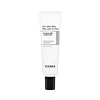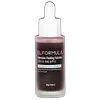What's inside
What's inside
 Key Ingredients
Key Ingredients

 Benefits
Benefits

 Concerns
Concerns

 Ingredients Side-by-side
Ingredients Side-by-side

Water
Skin ConditioningGlycolic Acid
BufferingLactic Acid
BufferingPotassium Hydroxide
BufferingGluconolactone
Skin ConditioningMandelic Acid
AntimicrobialDipropylene Glycol
HumectantPanthenol
Skin ConditioningSalicylic Acid 2%
MaskingMethylpropanediol
Solvent1,2-Hexanediol
Skin ConditioningOctyldodeceth-16
EmulsifyingCitric Acid
BufferingHydroxyethylcellulose
Emulsion StabilisingPentylene Glycol
Skin ConditioningSodium Polyacryloyldimethyl Taurate
Emulsion StabilisingCyanocobalamin
Skin ConditioningPolyacrylate Crosspolymer-6
Emulsion StabilisingHydroxypropyl Starch Phosphate
Ethylhexylglycerin
Skin ConditioningCapryloyl Salicylic Acid
ExfoliatingPolysorbate 60
EmulsifyingDisodium Phosphate
BufferingSodium Phosphate
BufferingTocopherol
AntioxidantAllantoin
Skin ConditioningHydrolyzed Hyaluronic Acid
HumectantWater, Glycolic Acid, Lactic Acid, Potassium Hydroxide, Gluconolactone, Mandelic Acid, Dipropylene Glycol, Panthenol, Salicylic Acid 2%, Methylpropanediol, 1,2-Hexanediol, Octyldodeceth-16, Citric Acid, Hydroxyethylcellulose, Pentylene Glycol, Sodium Polyacryloyldimethyl Taurate, Cyanocobalamin, Polyacrylate Crosspolymer-6, Hydroxypropyl Starch Phosphate, Ethylhexylglycerin, Capryloyl Salicylic Acid, Polysorbate 60, Disodium Phosphate, Sodium Phosphate, Tocopherol, Allantoin, Hydrolyzed Hyaluronic Acid
Water
Skin ConditioningGlycolic Acid
BufferingSodium Hydroxide
BufferingPentylene Glycol
Skin ConditioningGluconolactone
Skin ConditioningGlycerin
HumectantPropanediol
SolventXanthan Gum
Emulsifying1,2-Hexanediol
Skin ConditioningSalicylic Acid
MaskingAcacia Senegal Gum
MaskingC12-14 Alketh-12
EmulsifyingCaprylyl Glycol
EmollientHydrolyzed Gardenia Florida Extract
AntioxidantMaltodextrin
AbsorbentEthylhexylglycerin
Skin ConditioningSodium Phytate
Butylene Glycol
HumectantCentella Asiatica Extract
CleansingGlycine
BufferingPolygonum Cuspidatum Root Extract
AntioxidantScutellaria Baicalensis Root Extract
AstringentSerine
MaskingGlutamic Acid
HumectantGlycyrrhiza Glabra Root Extract
BleachingCamellia Sinensis Leaf Extract
AntimicrobialAspartic Acid
MaskingLeucine
Skin ConditioningRosmarinus Officinalis Leaf Extract
AntimicrobialChamomilla Recutita Flower Extract
MaskingAlanine
MaskingLysine
Skin ConditioningArginine
MaskingTyrosine
MaskingPhenylalanine
MaskingValine
MaskingThreonine
Proline
Skin ConditioningIsoleucine
Skin ConditioningTocopherol
AntioxidantHistidine
HumectantMethionine
Skin ConditioningCysteine
AntioxidantWater, Glycolic Acid, Sodium Hydroxide, Pentylene Glycol, Gluconolactone, Glycerin, Propanediol, Xanthan Gum, 1,2-Hexanediol, Salicylic Acid, Acacia Senegal Gum, C12-14 Alketh-12, Caprylyl Glycol, Hydrolyzed Gardenia Florida Extract, Maltodextrin, Ethylhexylglycerin, Sodium Phytate, Butylene Glycol, Centella Asiatica Extract, Glycine, Polygonum Cuspidatum Root Extract, Scutellaria Baicalensis Root Extract, Serine, Glutamic Acid, Glycyrrhiza Glabra Root Extract, Camellia Sinensis Leaf Extract, Aspartic Acid, Leucine, Rosmarinus Officinalis Leaf Extract, Chamomilla Recutita Flower Extract, Alanine, Lysine, Arginine, Tyrosine, Phenylalanine, Valine, Threonine, Proline, Isoleucine, Tocopherol, Histidine, Methionine, Cysteine
 Reviews
Reviews

Ingredients Explained
These ingredients are found in both products.
Ingredients higher up in an ingredient list are typically present in a larger amount.
1,2-Hexanediol is a synthetic liquid and another multi-functional powerhouse.
It is a:
- Humectant, drawing moisture into the skin
- Emollient, helping to soften skin
- Solvent, dispersing and stabilizing formulas
- Preservative booster, enhancing the antimicrobial activity of other preservatives
Ethylhexylglycerin (we can't pronounce this either) is commonly used as a preservative and skin softener. It is derived from glyceryl.
You might see Ethylhexylglycerin often paired with other preservatives such as phenoxyethanol. Ethylhexylglycerin has been found to increase the effectiveness of these other preservatives.
Gluconolactone is a PHA. PHAs are a great gentle alternative to traditional AHAs.
When applied, Gluconolactone has the same affect on skin as AHAs such as lactic acid. It helps dissolve the dead skin cells in the top layer of your skin. This improves texture and brightens the skin.
PHAs are more gentle than AHAs due to their larger structure. They do not penetrate as deeply as AHAs and take a longer time to dissolve dead cells. Studies show PHAs do not cause as much irritation.
Gluconolactone has some interesting properties:
In a 2004 study, Gluconolactone was found to prevent UV damage in mouse skin cells and has not been found to increase sun sensitivity. However, we still recommend wearing SPF daily.
This ingredient is is an created by reacting gluconic acid with an alcohol.
Learn more about GluconolactoneGlycolic Acid is arguably the most famous alpha hydroxy acid (AHA) with tons of research backing its benefits.
It is found naturally in sugar cane but the form used in skincare is usually synthetic for purity and stability.
Glycolic acid removes the top layer of dead skin cells to allow newer and fresher ones to emerge.
AHAs work by breaking down the structural “glue” that holds old skin cells in place. When that buildup is gone, your skin can renew itself more efficiently.
Research also shows glycolic acid stimulates collagen production, helping to firm and thicken the skin over time. This is one of its biggest advantages over other AHAs.
Overall, glycolic acid helps with:
Fun fact: Glycolic acid boosts skin hydration by helping it produce molecules that increase hyaluronic acid naturally.
To work best, glycolic acid products should have a pH between 3-4 (that’s where exfoliation is most effective but still gentle on skin).
The pH and concentration of a product are key to its effectiveness:
It is normal to feel a slight stinging sensation when using glycolic acid. This usually fades as your skin adjusts.
Because glycolic acid has the smallest molecular size in the AHA family, it can penetrate deeper, which enhances its effectiveness but also makes it more likely to irritate sensitive skin.
If your skin is very sensitive or prone to rosacea, glycolic acid may be too strong; in that case, try milder options like lactic acid or a PHA instead.
Recent studies suggest glycolic acid might even help protect against UV damage. But don’t skip sunscreen! Freshly exfoliated skin is more sensitive to the sun.
Glycolic acid is a skincare superstar. It smooths, brightens, hydrates, and firms the skin. Unless you’re highly sensitive, it’s well worth adding to your routine.
Read more about some other popular AHA's here:
Learn more about Glycolic AcidPentylene glycol is typically used within a product to thicken it. It also adds a smooth, soft, and moisturizing feel to the product. It is naturally found in plants such as sugar beets.
The hydrophilic trait of Pentylene Glycol makes it a humectant. As a humectant, Pentylene Glycol helps draw moisture from the air to your skin. This can help keep your skin hydrated.
This property also makes Pentylene Glycol a great texture enhancer. It can also help thicken or stabilize a product.
Pentylene Glycol also acts as a mild preservative and helps to keep a product microbe-free.
Some people may experience mild eye and skin irritation from Pentylene Glycol. We always recommend speaking with a professional about using this ingredient in your routine.
Pentylene Glycol has a low molecular weight and is part of the 1,2-glycol family.
Learn more about Pentylene GlycolSalicylic Acid (also known as beta hydroxy acid or BHA) is a well-known ingredient for treating skin that struggles with acne and clogged pores. It exfoliates both the skin's surface and deep within the pores to help clear out buildup, control oil, and reduce inflammation.
Unlike AHAs (alpha hydroxy acids), salicylic acid is oil-soluble. This allows it to penetrate into pores which makes it especially effective for treating blackheads and preventing future breakouts.
Salicylic acid is also known for its soothing properties. It has a similar structure to aspirin and can calm inflamed or irritated skin, making it a good option for acne-prone skin that is also sensitive.
Concentrations of 0.5-2% are recognized by the U.S. FDA as an over-the-counter topical acne product.
It can cause irritation and/or dryness if one's skin already has a compromised moisture barrier, so it's best to focus on repairing that before introducing this ingredient into your routine.
While salicylic acid does not increase sun sensitivity, it’s still important to wear sunscreen daily to protect your skin.
If you are looking for the ingredient called BHA or Butylated Hydroxyanisole, click here.
Learn more about Salicylic AcidTocopherol (also known as Vitamin E) is a common antioxidant used to help protect the skin from free-radicals and strengthen the skin barrier. It's also fat soluble - this means our skin is great at absorbing it.
Vitamin E also helps keep your natural skin lipids healthy. Your lipid skin barrier naturally consists of lipids, ceramides, and fatty acids. Vitamin E offers extra protection for your skin’s lipid barrier, keeping your skin healthy and nourished.
Another benefit is a bit of UV protection. Vitamin E helps reduce the damage caused by UVB rays. (It should not replace your sunscreen). Combining it with Vitamin C can decrease sunburned cells and hyperpigmentation after UV exposure.
You might have noticed Vitamin E + C often paired together. This is because it is great at stabilizing Vitamin C. Using the two together helps increase the effectiveness of both ingredients.
There are often claims that Vitamin E can reduce/prevent scarring, but these claims haven't been confirmed by scientific research.
Learn more about TocopherolWater. It's the most common cosmetic ingredient of all. You'll usually see it at the top of ingredient lists, meaning that it makes up the largest part of the product.
So why is it so popular? Water most often acts as a solvent - this means that it helps dissolve other ingredients into the formulation.
You'll also recognize water as that liquid we all need to stay alive. If you see this, drink a glass of water. Stay hydrated!
Learn more about Water